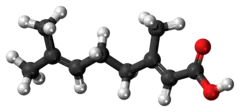Geranic acid
Geranic acid, or 3,7-dimethyl-2,6-octadienoic acid, is a pheromone used by some organisms.[1] It is a double bond isomer of nerolic acid.
 | |
 | |
| Names | |
|---|---|
| Preferred IUPAC name
(2E)-3,7-Dimethylocta-2,6-dienoic acid | |
| Other names
Geranic acid | |
| Identifiers | |
3D model (JSmol) |
|
| ChEBI | |
| ChEMBL | |
| ChemSpider | |
PubChem CID |
|
| UNII | |
CompTox Dashboard (EPA) |
|
| |
| |
| Properties | |
| C10H16O2 | |
| Molar mass | 168.236 g·mol−1 |
| Appearance | Oily liquid |
| Density | 0.97 g/cm3 |
| Boiling point | 249 to 251 °C (480 to 484 °F; 522 to 524 K) |
| Related compounds | |
Related acids |
Nerolic acid, Octanoic acid |
Related compounds |
Geraniol Geranial |
Except where otherwise noted, data are given for materials in their standard state (at 25 °C [77 °F], 100 kPa).
Infobox references | |
Pharmacology
Choline geranate (also described as Choline And Geranic acid, or CAGE) has been developed as a novel biocompatible antiseptic material capable of penetrating skin and aiding the transdermal delivery of co-administered antibiotics.
The antibacterial properties of CAGE were analyzed against 24 and 72 hour old biofilms of 11 clinically isolated ESKAPE pathogens (defined as Enterococcus faecium, Staphylococcus aureus, Klebsiella pneumoniae, Acinetobacter baumanii, Pseudomonas aeruginosa, and Enterobacter sp, respectively), including multidrug resistant (MDR) isolates.
CAGE was observed to eradicate in vitro biofilms at concentrations as low as 3.56 mM (0.156% v:v) in as little as 2 hours, which represents both an improved potency and rate of biofilm eradication relative to that reported for most common standard-of-care topical antiseptics in current use. In vitro time-kill studies on 24 hour old Staphylococcus aureus biofilms indicate that CAGE exerts its antibacterial effect upon contact and a 0.1% v:v solution reduced biofilm viability by over three orders of magnitude (a 3log10 reduction) in 15 minutes.
Furthermore, disruption of the protective layer of exopolymeric substances in mature biofilms of Staphylococcus aureus by CAGE (0.1% v:v) was observed in 120 minutes. Insight into the mechanism of action of CAGE was provided with molecular modeling studies alongside in vitro antibiofilm assays. The geranate ion and geranic acid components of CAGE are predicted to act in concert to integrate into bacterial membranes, affect membrane thinning and perturb membrane homeostasis. [2]
References
- Geranic acid, pherobase.com
- Greene, J. R.; Merrett, K. L.; Heyert, A. J.; Simmons, L. F.; Migliori, C. M.; Vogt, K. C.; Castro, R. S.; Phillips, P. D.; Baker, J. L.; Lindberg, G. E.; Fox, D. T.; Del Sesto, R. E.; Koppisch, A. T. (2019). "Scope and efficacy of the broad-spectrum topical antiseptic choline geranate". PLOS ONE. 14 (9): e0222211. Bibcode:2019PLoSO..1422211G. doi:10.1371/journal.pone.0222211. PMC 6748422. PMID 31527873.